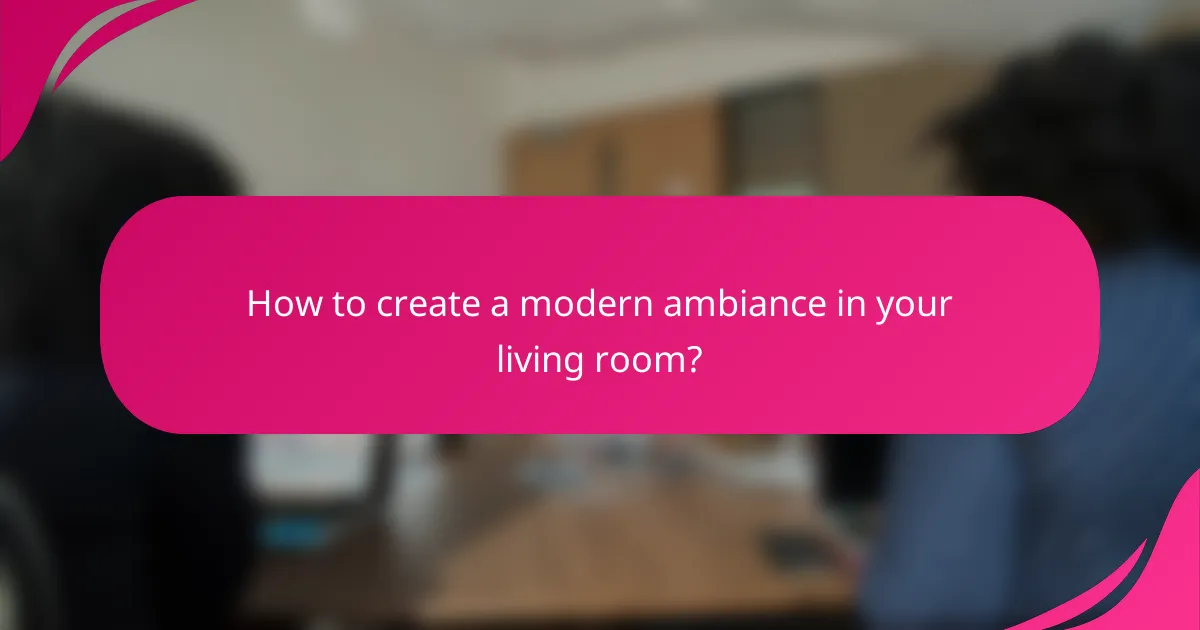Transforming your living room into a modern sanctuary involves a careful selection of furniture, colors, and lighting that prioritize both style and comfort. By incorporating ergonomic pieces and soft textiles, you can create a welcoming atmosphere, while effective lighting options like LED fixtures and smart systems enhance the overall ambiance. Embrace simplicity and functionality to achieve a cohesive design that reflects contemporary trends.

How to create a modern ambiance in your living room?
Creating a modern ambiance in your living room involves selecting the right furniture, colors, lighting, and layout to enhance comfort and style. Focus on simplicity, functionality, and a cohesive design that reflects contemporary trends.
Incorporate minimalist furniture
Minimalist furniture emphasizes clean lines and functional design, making it ideal for a modern living room. Choose pieces that serve multiple purposes, such as a coffee table with storage or a sofa bed.
Look for furniture made from materials like metal, glass, or light-colored wood to maintain an airy feel. Avoid bulky items that can overwhelm the space, opting instead for sleek designs that complement your overall aesthetic.
Use neutral color palettes
A neutral color palette creates a calming and sophisticated atmosphere in your living room. Shades like white, beige, gray, and soft pastels can serve as a backdrop for your decor, allowing other elements to stand out.
Consider using a combination of these colors for walls, furniture, and accessories. This approach not only enhances the modern ambiance but also makes it easier to change decor elements without needing a complete overhaul.
Add decorative lighting fixtures
Decorative lighting fixtures can significantly enhance the modern ambiance of your living room. Choose statement pieces such as pendant lights or sculptural floor lamps that serve as both functional and artistic elements.
Incorporate layered lighting by combining ambient, task, and accent lights. This creates a warm and inviting atmosphere while allowing you to adjust the brightness according to your needs.
Integrate natural elements
Integrating natural elements adds warmth and texture to a modern living room. Consider incorporating plants, wooden accents, or stone features to create a balanced and inviting space.
Choose low-maintenance plants like succulents or snake plants that thrive indoors. Natural materials in furniture or decor can enhance the overall aesthetic and promote a sense of tranquility.
Utilize open space design
Utilizing open space design maximizes the flow and functionality of your living room. Aim for a layout that encourages movement and interaction, avoiding clutter and unnecessary barriers.
Consider using area rugs to define different zones within the space, such as a seating area or reading nook. This approach maintains an open feel while providing structure to your living room layout.

What are the best ways to increase comfort in your living room?
To enhance comfort in your living room, focus on ergonomic furniture, soft textiles, effective lighting, and temperature control. These elements work together to create a welcoming and relaxing environment.
Choose ergonomic seating options
Ergonomic seating options, such as chairs and sofas designed to support the natural curvature of the body, can significantly improve comfort. Look for furniture with adjustable features, lumbar support, and appropriate seat height to accommodate various body types.
Consider materials like memory foam or high-density cushions, which provide better support and durability. Popular choices include recliners, sectional sofas, and accent chairs that allow for varied seating positions.
Add soft textiles and cushions
Incorporating soft textiles and cushions can enhance the tactile comfort of your living room. Use plush throw pillows, blankets, and area rugs to create a cozy atmosphere that invites relaxation.
Select materials such as cotton, wool, or velvet for a luxurious feel. Layering different textures can also add visual interest while improving overall comfort.
Implement adjustable lighting
Adjustable lighting is crucial for creating a comfortable ambiance in your living room. Use dimmable LED bulbs, floor lamps, and table lamps to control brightness levels based on the time of day or activity.
Consider adding smart lighting systems that allow you to customize settings via an app or voice command. This flexibility can enhance mood and functionality, making the space more inviting.
Incorporate temperature control solutions
Temperature control solutions, such as ceiling fans, portable heaters, or air conditioning units, are essential for maintaining comfort in your living room. Ensure that your space is well-ventilated and that heating or cooling systems are energy-efficient.
For optimal comfort, aim to keep the temperature between 20-22°C (68-72°F) during cooler months and slightly cooler in the summer. Consider using smart thermostats to automate temperature adjustments based on your schedule.

Which lighting options improve living room aesthetics?
Effective lighting options can significantly enhance the aesthetics of a living room by creating a modern ambiance, increasing comfort, and improving visibility. Key choices include LED recessed lighting, floor lamps, smart lighting systems, and accent lighting for artwork.
Install LED recessed lighting
LED recessed lighting offers a sleek, modern look while providing ample illumination. These fixtures are installed into the ceiling, creating a clean appearance that blends seamlessly with the decor.
When choosing LED recessed lights, consider the color temperature; warmer tones (around 2700K to 3000K) create a cozy atmosphere, while cooler tones (4000K to 5000K) lend a more energetic feel. Ensure proper spacing between fixtures to avoid dark spots, typically around 4 to 6 feet apart.
Use floor lamps for ambient lighting
Floor lamps are versatile and can serve as both functional and decorative elements in a living room. They provide ambient lighting that softens the overall brightness and adds warmth to the space.
When selecting a floor lamp, look for adjustable models that allow you to direct light where it’s needed most. Consider the height and style to ensure it complements your existing furniture and decor.
Incorporate smart lighting systems
Smart lighting systems enable you to control brightness and color through your smartphone or voice commands, enhancing convenience and customization. These systems can create different moods and settings for various occasions.
Choose systems compatible with your existing home automation setup. Look for features like scheduling and remote access, which can help save energy and improve security when you’re away from home.
Utilize accent lighting for artwork
Accent lighting highlights artwork and architectural features, adding depth and interest to your living room. This type of lighting draws attention to specific areas, enhancing the overall aesthetic appeal.
Consider using adjustable spotlights or picture lights to focus on artwork. Ensure the lighting is not too harsh; a soft glow will enhance colors and textures without overwhelming the viewer.

What are the key elements of a living room update?
Key elements of a living room update include modernizing the ambiance, enhancing comfort, and improving lighting. These updates can transform the space into a more inviting and functional area for relaxation and socializing.
Assess current layout and design
Begin by evaluating the existing layout and design of your living room. Consider how the current arrangement affects flow and functionality. Identify any furniture pieces that obstruct movement or do not serve a purpose.
Take measurements of the space to understand what can fit comfortably. A well-planned layout should promote easy conversation and accessibility, allowing for a natural flow between seating areas and other elements like entertainment units.
Identify budget and materials needed
Establish a budget for your living room update to guide your choices. A typical budget might range from a few hundred to several thousand dollars, depending on the extent of the changes you plan to make. Include costs for furniture, decor, and lighting fixtures.
Next, list the materials needed for your update. This may include paint, flooring, new furniture, or lighting solutions. Prioritize quality materials that enhance comfort and durability, and consider how they fit within your overall budget.
